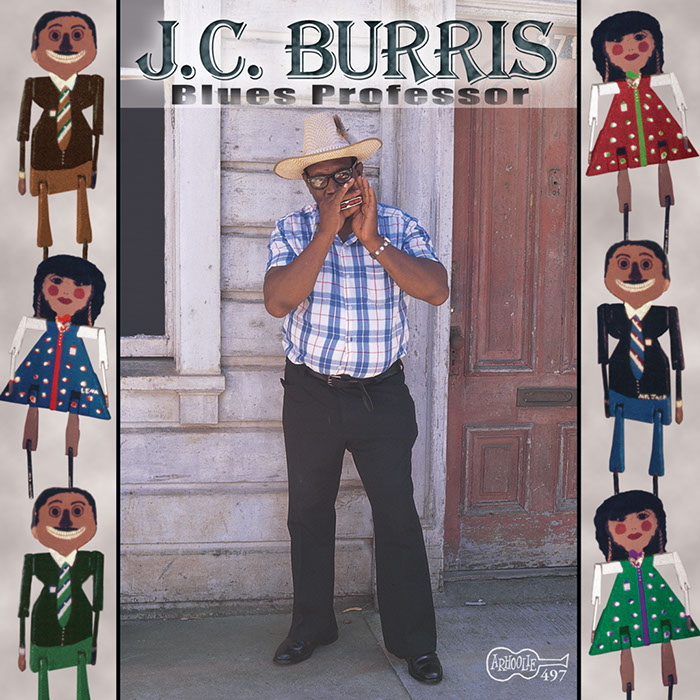The Blues Professor and His Dancing Dolls

While sorting through the Strachwitz Photo Collection, I became intrigued by several photographs of blues harmonica player Johnny “J.C.” Burris posing with hand-carved wooden dolls at his feet. Though I wasn’t familiar with Burris’s work, these dolls captured my curiosity, and I wondered why they frequently appeared in photos with Burris over the years. The photographs didn’t offer any clues regarding the dolls’ origin, so I decided to do a little digging.

J.C. Burris with his dancing doll Mr. Jack in 1975. Photo by Chris Strachwitz.
J.C. Burris was born in Kings Mountain, North Carolina in 1928. He learned to play harmonica from his uncle, blues legend Sonny Terry. Though never as prolific or well-known as his uncle, Burris did perform and record in New York in the 1950s, and after a few years, he relocated to San Francisco. Burris’s country blues sound was heavily influenced by his uncle, but he developed his own style which incorporated traditional percussive folk instruments into his music, such as African rhythm bones, foot stomps, hand jive, and the tap-tap-taps of his hand-carved “dancing dolls”, Mr. Jack and Mary Lee.
J.C. Burris with his puppet Mr. Jack in 1978. Source: YouTube.
Burris created Mr. Jack in 1968. Mr. Jack finally gained a dancing partner 19 years later when Burris carved the final version of Mary Lee, just one year before his death in 1988. The dolls, with loosely articulated limbs, swung their arms and tapped their feet on a wooden plank placed between Burris’s feet as he rhythmically tapped their heads. Mr. Jack and an earlier, minimalist version of Mary Lee are featured on the cover of Arhoolie’s J.C. Burris: Blues Professor album from 2001. On the cover, the dolls’ painted attire differs from the styles of their later years. It appears that Burris frequently updated the dolls’ painted outfits, though Mr. Jack’s mustache over a wide toothy grin and Mary Lee’s rosy cheeks always remained. By the end of Burris’ life, the final version of Mary Lee had developed real locks of hair and a wide smile to match her dancing partner, Mr. Jack.

Cover of Blues Professor by J.C. Burris (Arhoolie 497, 2001).
Mr. Jack and Mary Lee were sold at auction in 2020. Though their estimated value was $800-$1,200, they sold for $400. Their current whereabouts are unknown, but hopefully they are well cared for, still smiling, and still dancing.
Jessica Luther is an MLIS student at San Jose State University and a library technician based in Alameda, California.
Source: Johnmoran.com
References
John Moran. (2022). Auction lot 102: J.C. Burris. https://www.johnmoran.com/auction-lot/j.c.-burris-1928-1988-american-mr.-jack-1_D1B43C1A58/.
Smithsonian Folkways Recordings. (2022). Blues Professor: J.C. Burris. https://folkways.si.edu/jc-burris/blues-professor/blues/music/album/smithsonian.
Unterberger, R. (n.d.). J.C. Burris biography. AllMusic. https://www.allmusic.com/artist/jc-burris-mn0000097506/biography.

